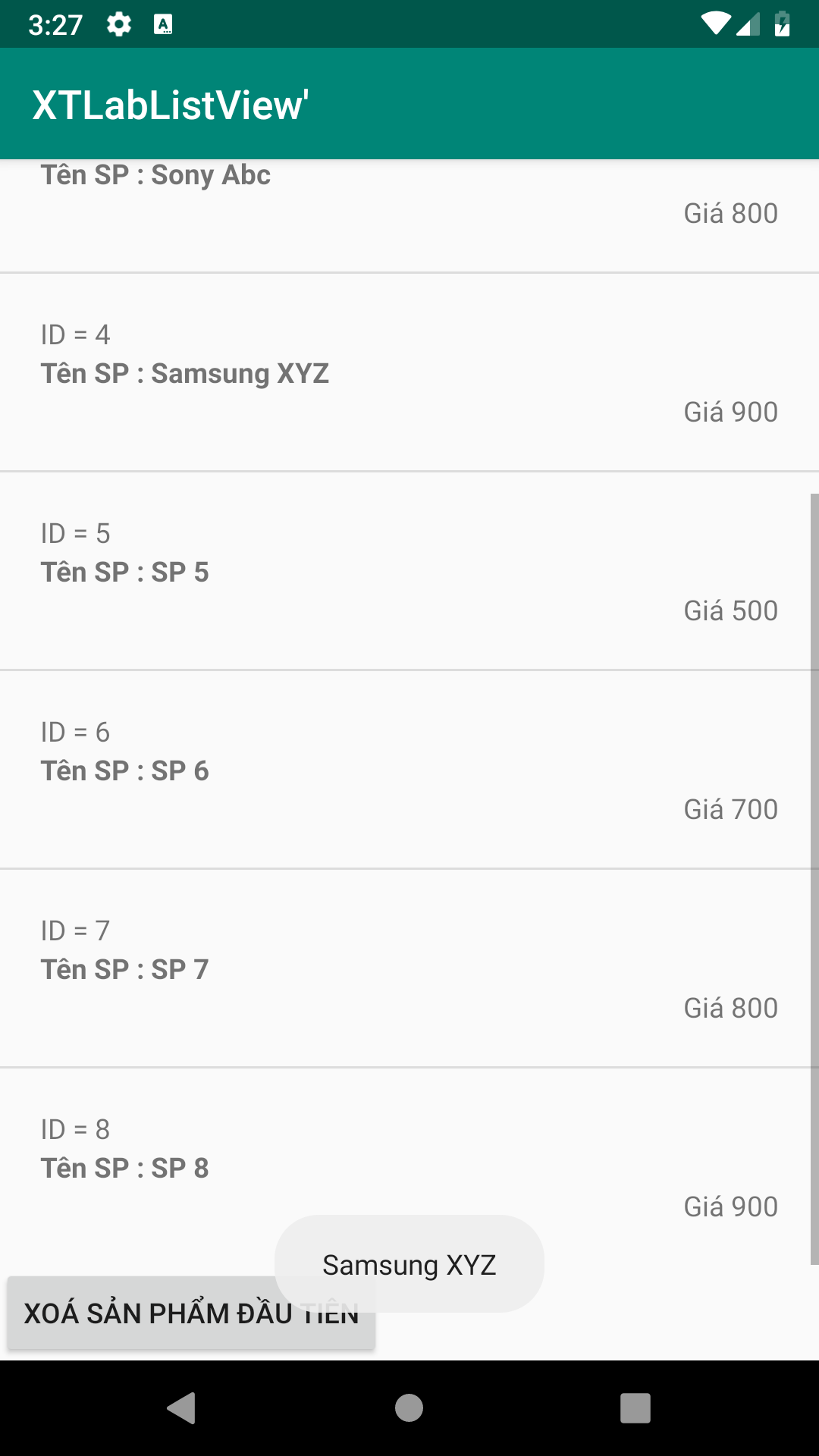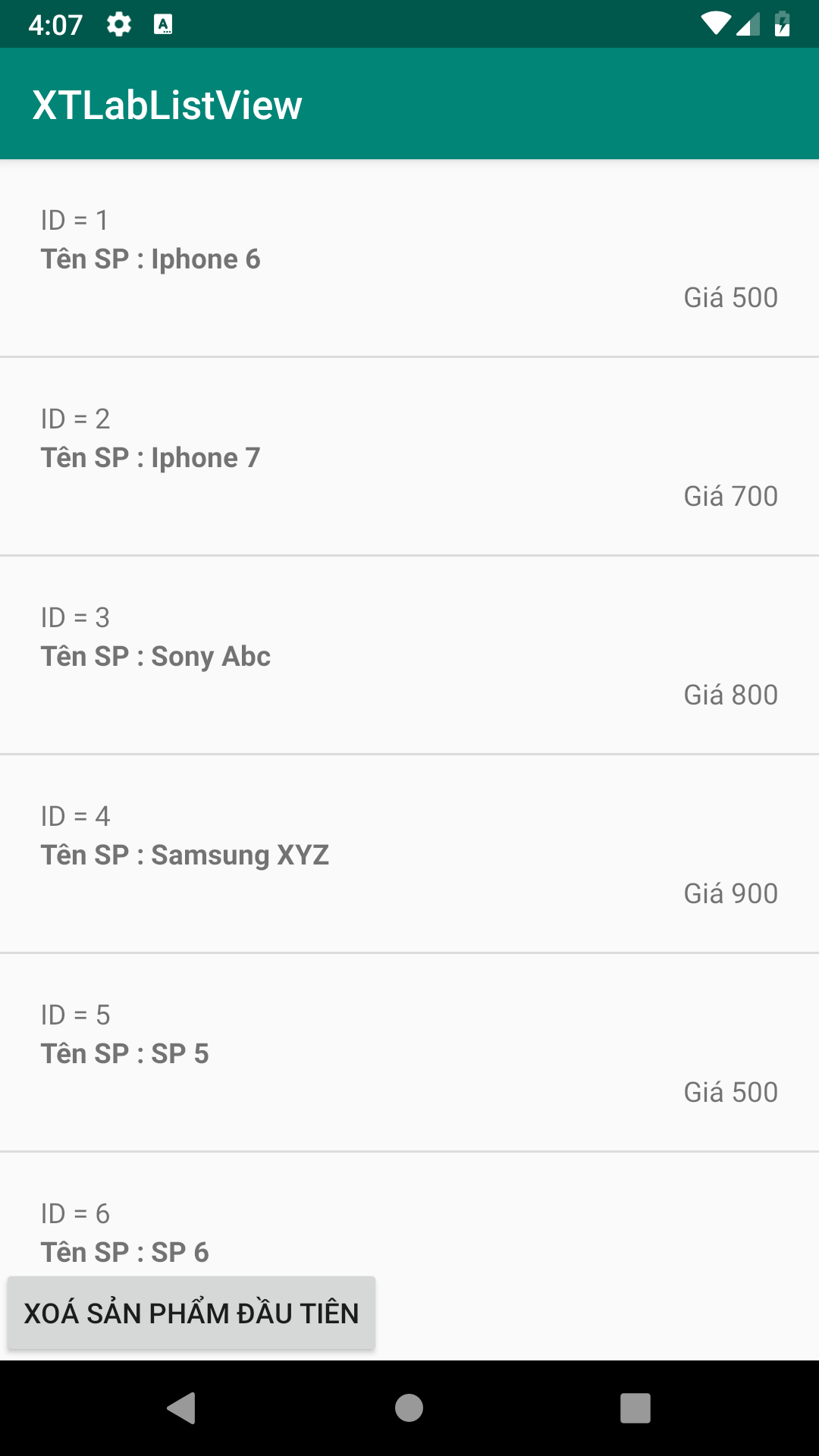ListView trong Android
ListView là phần tử View được dùng để hiện thị dữ liệu là một danh sách (mảng) từ một nguồn cấp gọi là Adapter,
các bước để tạo và sử dụng ListView gồm có:
Tương tự như các View khác, ví dụ:
<ListView
android:id="@+id/listproduct"
android:layout_width="match_parent"
android:layout_height="match_parent" />
Gán cho ListView một Adapter là nguồn cấp dữ liệu cho nó
Xây dựng một Adapter cho ListView ở phần dưới, sau khi có Adapter cần thiết lập cho ListView, ví dụ trong onCreate của Activity:
listViewProduct = findViewById(R.id.listproduct); listViewProduct.setAdapter(productListViewAdapter);
Khi đã gán Adapter vào ListView, thì ListView sẽ dùng Adapter này xác định cần hiện thị bao nhiêu phần tử, mỗi phần tử có View như thế nào do Adapter tạo và đính vào ListView, mỗi khi dữ liệu Adapter quản lý thay đổi, cần thông báo cho ListView biết mà cập nhật bằng cách gọi:
adapter.notifyDataSetChanged();
Xây dựng Adapter cho ListView
Như đã nói trên, Adapter là mô hình cung cấp dữ liệu cho ListView, nó có chức năng tạo các View phần tử, gán dữ liệu vào phần tử View con trong ListView.
Để tạo ra một Adapter riêng chỉ cần kế thừa triển khai lớp trừu tượng BaseAdapter, trong đó cần overrided các phương thức như dưới đây (Ví dụ xây dựng lớp MyAdapter):
class MyAdapter extends BaseAdapter {
@Override
public int getCount() {
//Cần trả về số phần tử mà ListView hiện thị
return 0;
}
@Override
public Object getItem(int position) {
//Cần trả về đối tượng dữ liệu phần tử ở vị trí position
return null;
}
@Override
public long getItemId(int position) {
//Trả về một ID liên quan đến phần tử ở vị trí position
return 0;
}
@Override
public View getView(int position, View convertView, ViewGroup parent) {
//convertView là View hiện thị phần tử, nếu là null cần tạo mới
//(có thể nạp từ layout bằng View.inflate)
//Cuối cùng là gán dữ liệu ở vị trí possition vào View và trả về đối
//tượng View này
return null;
}
}
Ví dụ ListView trong Android
Nội dung Ví dụ
Ứng dụng hiện thị một danh sách các sản phẩm đơn giản, sản phẩm được trình bày trong một layout có các thông tin như ID, tên sản phẩm, giá. Khi bấm vào chọn một sản phẩm, Pop up lên thông báo tên sản phẩm đó. Có chức năng cho phép xoá phần tử đầu tiên của danh sách (sau khi xoá ListView cập nhật lại)

Khởi tạo Ví dụ
Chạy Android Studio và tạo ứng dụng đặt tên, ví dụ XTLabListView bằng mẫu Empty Activity, sau đó thay nội dung activity_main.xml
thành giao diện đơn giản, riêng có ListView như sau:
<?xml version="1.0" encoding="utf-8"?>
<LinearLayout xmlns:android="http://schemas.android.com/apk/res/android"
android:layout_width="match_parent"
android:layout_height="match_parent"
android:fitsSystemWindows="true"
android:orientation="vertical">
<ListView
android:id="@+id/listproduct"
android:layout_width="match_parent"
android:layout_height="0dp"
android:layout_weight="1" />
<Button
android:id="@+id/delete"
android:layout_width="wrap_content"
android:layout_height="wrap_content"
android:text="Xoá sản phẩm đầu tiên" />
</LinearLayout>
Model dữ liệu sản phẩm
Mỗi sản phẩm đơn giản hiện thị ID, tên sản phẩm, giá nên ta tạo ra một mô hình dữ liệu của nó như sau:
//Model phần tử dữ liệu hiện
class Product {
String name;
int price;
int productID;
public Product(int productID, String name, int price) {
this.name = name;
this.price = price;
this.productID = productID;
}
}
Trong MainActivity tạo ra một mảng chứa dữ liệu mẫu các Product (dùng ArrayList), ví dụ:
ArrayList<Product> listProduct; //Mảng dữ liệu sản phẩm
@Override
protected void onCreate(Bundle savedInstanceState) {
super.onCreate(savedInstanceState);
setContentView(R.layout.activity_main);
//Khoi tao ListProduct, tự sinh một số dữ liệu
listProduct = new ArrayList<>();
listProduct.add(new Product(1, "Iphone 6", 500));
listProduct.add(new Product(2, "Iphone 7", 700));
listProduct.add(new Product(3, "Sony Abc", 800));
listProduct.add(new Product(4, "Samsung XYZ", 900));
listProduct.add(new Product(5, "SP 5", 500));
listProduct.add(new Product(6, "SP 6", 700));
listProduct.add(new Product(7, "SP 7", 800));
listProduct.add(new Product(8, "SP 8", 900));
}
Tạo Adapter cho ListView hiện thị sản phầm
Adapter này xây dựng để liên kết với mảng dữ liệu sản phẩm ở trên (ArrayList<Product> listProduct), Adapter tạo ra các View để hiện
thị sản phẩm, nên đầu tiên tạo ra layout hiện thị một sản phẩm trong listview, layout này được inflate khi cần thiết.
layout/product_view.xml (bạn có thể trành bày layout theo cách đẹp đẽ, phức tạp của bạn).
<?xml version="1.0" encoding="utf-8"?>
<LinearLayout xmlns:android="http://schemas.android.com/apk/res/android"
android:layout_width="match_parent"
android:layout_height="wrap_content"
android:orientation="vertical"
android:padding="20dp">
<TextView
android:id="@+id/idproduct"
android:layout_width="match_parent"
android:layout_height="wrap_content"
android:text="1" />
<TextView
android:id="@+id/nameproduct"
android:layout_width="match_parent"
android:layout_height="wrap_content"
android:text="ProductName"
android:textStyle="bold" />
<TextView
android:id="@+id/priceproduct"
android:layout_width="match_parent"
android:layout_height="wrap_content"
android:gravity="right"
android:text="1000" />
</LinearLayout>
Giờ là lúc tạo ra Adapter, đặt tên lớp là ProductListViewAdapter, nội dung code như sau
class ProductListViewAdapter extends BaseAdapter {
//Dữ liệu liên kết bởi Adapter là một mảng các sản phẩm
final ArrayList<Product> listProduct;
ProductListViewAdapter(ArrayList<Product> listProduct) {
this.listProduct = listProduct;
}
@Override
public int getCount() {
//Trả về tổng số phần tử, nó được gọi bởi ListView
return listProduct.size();
}
@Override
public Object getItem(int position) {
//Trả về dữ liệu ở vị trí position của Adapter, tương ứng là phần tử
//có chỉ số position trong listProduct
return listProduct.get(position);
}
@Override
public long getItemId(int position) {
//Trả về một ID của phần
return listProduct.get(position).productID;
}
@Override
public View getView(int position, View convertView, ViewGroup parent) {
//convertView là View của phần tử ListView, nếu convertView != null nghĩa là
//View này được sử dụng lại, chỉ việc cập nhật nội dung mới
//Nếu null cần tạo mới
View viewProduct;
if (convertView == null) {
viewProduct = View.inflate(parent.getContext(), R.layout.product_view, null);
} else viewProduct = convertView;
//Bind sữ liệu phần tử vào View
Product product = (Product) getItem(position);
((TextView) viewProduct.findViewById(R.id.idproduct)).setText(String.format("ID = %d", product.productID));
((TextView) viewProduct.findViewById(R.id.nameproduct)).setText(String.format("Tên SP : %s", product.name));
((TextView) viewProduct.findViewById(R.id.priceproduct)).setText(String.format("Giá %d", product.price));
return viewProduct;
}
}
Quay trở lại áp dụng, trong onCreate tạo ra đối tượng từ lớp ProductListViewAdapter (dữ liệu khởi tạo là mảng danh sách sản phẩm listProduct),
biến Adapter này đặt tên là productListViewAdapter, sau đó gán nó cho ListView, đến đây thì ListView sẵn sàng hiện thị danh sách
các sản phẩm của bạn!
Ngoài ra có thêm một số đoạn code tuỳ chọn như listViewProduct.setOnItemClickListener để bắt sự kiện khi bấm chọn một phần tử và
bấm vào nút bấm để xoá phần tử đầu tiên. Code đầy đủ tổng hợp hoàn chỉnh lại của ứng dụng như sau:
MainActivity.java
package net.xuanthulab.xtlablistview;
import android.os.Bundle;
import android.support.v7.app.AppCompatActivity;
import android.view.View;
import android.view.ViewGroup;
import android.widget.AdapterView;
import android.widget.BaseAdapter;
import android.widget.ListView;
import android.widget.TextView;
import android.widget.Toast;
import java.util.ArrayList;
public class MainActivity extends AppCompatActivity {
ArrayList<Product> listProduct;
ProductListViewAdapter productListViewAdapter;
ListView listViewProduct;
@Override
protected void onCreate(Bundle savedInstanceState) {
super.onCreate(savedInstanceState);
setContentView(R.layout.activity_main);
//Khoi tao ListProduct
listProduct = new ArrayList<>();
listProduct.add(new Product(1, "Iphone 6", 500));
listProduct.add(new Product(2, "Iphone 7", 700));
listProduct.add(new Product(3, "Sony Abc", 800));
listProduct.add(new Product(4, "Samsung XYZ", 900));
listProduct.add(new Product(5, "SP 5", 500));
listProduct.add(new Product(6, "SP 6", 700));
listProduct.add(new Product(7, "SP 7", 800));
listProduct.add(new Product(8, "SP 8", 900));
productListViewAdapter = new ProductListViewAdapter(listProduct);
listViewProduct = findViewById(R.id.listproduct);
listViewProduct.setAdapter(productListViewAdapter);
//Lắng nghe bắt sự kiện một phần tử danh sách được chọn
listViewProduct.setOnItemClickListener(new AdapterView.OnItemClickListener() {
@Override
public void onItemClick(AdapterView<?> parent, View view, int position, long id) {
Product product = (Product) productListViewAdapter.getItem(position);
//Làm gì đó khi chọn sản phẩm (ví dụ tạo một Activity hiện thị chi tiết, biên tập ..)
Toast.makeText(MainActivity.this, product.name, Toast.LENGTH_LONG).show();
}
});
findViewById(R.id.delete).setOnClickListener(new View.OnClickListener() {
@Override
public void onClick(View v) {
if (listProduct.size() > 0) {
//Xoá phần tử đầu tiên của danh sách
int productpost = 0;
listProduct.remove(productpost);
//Thông báo cho ListView biết dữ liệu đã thay đổi (cập nhật, xoá ...)
productListViewAdapter.notifyDataSetChanged();
}
}
});
}
//Model phần tử dữ liệu hiện
class Product {
String name;
int price;
int productID;
public Product(int productID, String name, int price) {
this.name = name;
this.price = price;
this.productID = productID;
}
}
class ProductListViewAdapter extends BaseAdapter {
//Dữ liệu liên kết bởi Adapter là một mảng các sản phẩm
final ArrayList<Product> listProduct;
ProductListViewAdapter(ArrayList<Product> listProduct) {
this.listProduct = listProduct;
}
@Override
public int getCount() {
//Trả về tổng số phần tử, nó được gọi bởi ListView
return listProduct.size();
}
@Override
public Object getItem(int position) {
//Trả về dữ liệu ở vị trí position của Adapter, tương ứng là phần tử
//có chỉ số position trong listProduct
return listProduct.get(position);
}
@Override
public long getItemId(int position) {
//Trả về một ID của phần
return listProduct.get(position).productID;
}
@Override
public View getView(int position, View convertView, ViewGroup parent) {
//convertView là View của phần tử ListView, nếu convertView != null nghĩa là
//View này được sử dụng lại, chỉ việc cập nhật nội dung mới
//Nếu null cần tạo mới
View viewProduct;
if (convertView == null) {
viewProduct = View.inflate(parent.getContext(), R.layout.product_view, null);
} else viewProduct = convertView;
//Bind sữ liệu phần tử vào View
Product product = (Product) getItem(position);
((TextView) viewProduct.findViewById(R.id.idproduct)).setText(String.format("ID = %d", product.productID));
((TextView) viewProduct.findViewById(R.id.nameproduct)).setText(String.format("Tên SP : %s", product.name));
((TextView) viewProduct.findViewById(R.id.priceproduct)).setText(String.format("Giá %d", product.price));
return viewProduct;
}
}
}



Ví dụ này lưu tại https://github.com/xuanthulabnet/android-listview-example, có thể tải vể bằng lệnh Git: git clone git@github.com:xuanthulabnet/android-listview-example.git

